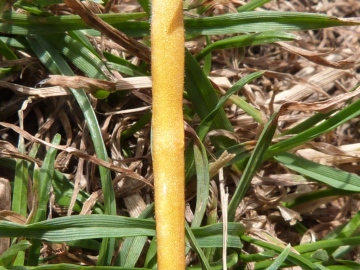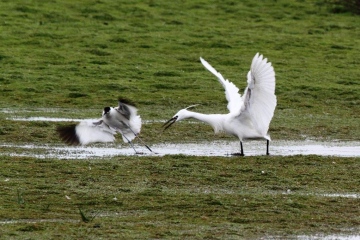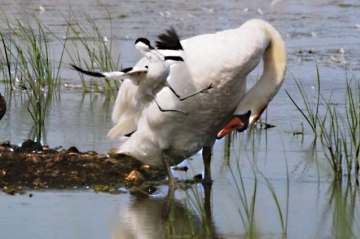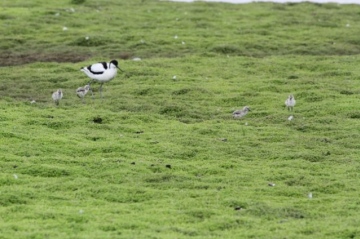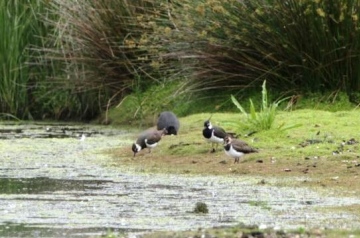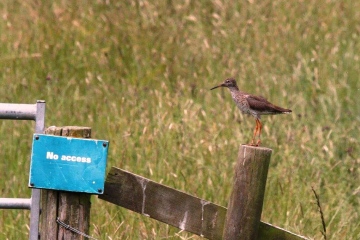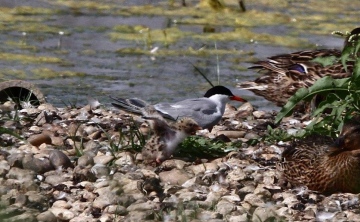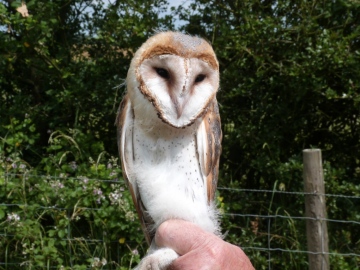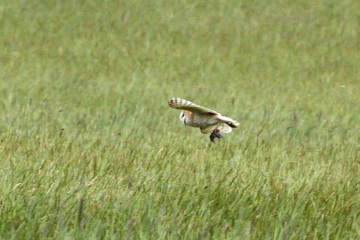If you look at the females' hind legs they are quite distinctive, with whitish hairs covering the lower part (tibia) and a large brush of black hairs on the first foot segment below that. The male is one of only a few bees with bold yellow coloration on its face. See http://www.bwars.com/index.php?q=bee/melittidae/macropis-europaea ![]() for photos of this bee and further information about its ecology.
for photos of this bee and further information about its ecology.
Your Forum
The weblog below is for naturalists to use to report interesting sightings, ask questions, report on field meetings and generally post pictures and any information or questions generally relevant in some way to the wildlife and geology of Essex. You will need to register and be logged-on to post to the forum, and you need to upload pictures first, for use in posts. Find out more
|
Thu 17th July 2014 20:13 by Adrian Knowles Do you have Dotted Loosestrife in your garden?
If so, take a look at the bees foraging at its flowers. I did this in my garden just over the border in Suffolk and discovered a Nationally Scarce bee Macropis europaea. In the wild it is very much associated with the wild Yellow Loosestrife, which is thin on the ground in my part of Suffolk and even rarer in Essex. Nevertheless, this female had found my one square metre of Dotted Loosestrife from a population quite unknown to me. My nearest record of the bee in Suffolk is tens of miles away. In Essex there are only two post-1990 locations, both right in the south of the county.
Fri 11th July 2014 10:19 by Graham Smith One for you Mary
Mary,
Have you any idea what this might be? It was growing on the stems of Yorkshire Fog at Blue House Farm on 7th July. There were several others grasses present - Meadow Foxtail, Crested Dog's-tail and Creeping Bent among them - but this fungus was confined to Holcus. It had the texture of a Reedmace head but its slight hairiness may be those of the grass growing through it. I know you are one for 'little brown jobs so you might be able to point me in the right direction. Perhaps I should put the photo on the Club's Facebook page as I have been reading Simon's article in the last newsletter. I am afraid that Facebook and Twitter have always been a step too far for this old Luddite. All that Like and Dislike, Friends and Followers business - it sounds far too young for me! But then I once vowed never to use a computer, then vowed never to use the Internet, then vowed never to have an email address etc etc etc. Now the mere thought of writing all those letters instead............ And, of course, anything that helps promote the Club I'm all for. Wed 2nd July 2014 21:03 by Mary Smith Birds everywhere
What wonderful stories and pictures you have put together, Graham! I do like the Class 4D with badly behaved avocets. I usually see them feeding peacefully in the Thames estuary mud, and never a squabble. Maybe breeding time, with youngsters about, is different. Just like teenagers!
I was out on Monday in Harold Wood, an area not noted for its birds, but near an abandoned and overgrown car park was a group of Tits who were 'whistling'(?) to each other, with long tails so presumably Long-tailed Tits. They were playing acrobatics between a fence with scrub on one side and assorted youngish trees on the opposite side, with the birds whizzing to and fro and turning somersaults in the air as they went, all 'whistling' in high-pitched songs to each other. I stood and watched for a few minutes before going on. But birds squabble aplenty in our garden and nearby, though a bit quieter now. These are the wretched bullies of 5E, but getting ready to leave school now. Yes, I am seeing Ring-necked Parakeets filling suburbia, making a major nuisance of themselves. They show off to each other and scare away the smaller birds no end. I have an elderly aunt (97) who has a bird feeder and a bowl of water she can see from her favourite chair. She can give you a running commentary on the birds that visit, and the large green-blue Parakeets are her pet hate!! They make a dickens of a racket, which she can hear even though she is very deaf, and they scare away all the smaller birds. Any ideas as to how to keep them out of the food and drink for the smaller birds? Meanwhile, I was disappointed to learn recently that 'my Robin' is probably at least 3, but it is so hard to tell one from another. However many there are, they come to me whenever I am digging, or turning over earth as in digging out new potatoes, and they like to hunt in the turned-over soil. They fly back to the nest with beaks full of assorted invertebrates. But I only ever see one at a time, so why do folk say there are several? Wed 2nd July 2014 17:52 by Graham Smith The C lass of 2014 Part Two
And now for Class 4D. Avocets. They are noisy, bumptious, anti-social, and given to throwing temper tantrums at the slightest provocation; they also delight in beating up creatures smaller than themselves. And that is just the parents. Birds much larger than themselves as well, as these two photos by John Lilley demonstrate.
The egret is a potential threat to very young chicks but the swan is more likely to inadvertently flatten the Avocet’s eggs with its big flat feet. Avocets often nest communally, as at Blue House, and the bickering tends to be kept to a minimum until the eggs hatch, then all hell is let loose. Their method of chick rearing is to let their offspring do whatever they want and to attack anything else – ranging in size from swans to wagtails (even dragonflies and bumblebees on occasion)- that comes near them, these unfortunates also including the chicks of neighbours and any innocent Lapwing or Redshank fledgling that wanders by. The one thing they have going in their favour is that any passing crow or harrier meets with a communal response, being buffeted by up to a dozen birds, whereas Lapwings tend to lose interest once the predator has left their territory. Still, the Lapwing is more my sort of bird. It is quieter, better mannered, more discreet; assertive when it comes to defending its territory and its young but the majority of its confrontations are ritualistic, seldom breaking down to serious fights. It has a range of distress calls to match the degree of threat to its young and to warn them to stay hidden, the shrillest and most fearful of these being reserved for Mustelids such as Stoats and Weasels. Alas, like the young of many species they do not always heed their parents and that can lead to their downfall when foxes are around. Fortunately, the 2km long fox-proof fence which the Blue House volunteers laboured long and hard to put in place skirting Round Marsh – the main wader breeding area on the farm – has worked well during the past two years. A fox was seen inside the fence on a couple of occasions last spring but did no damage. The one I saw was furiously licking its hindquarters and we conjectured that it had received a kick in the pants on entering the marsh and hopefully got another when exiting it. Also, the neighbouring landowner no longer runs a shoot, and therefore no longer shoots foxes, and this probably improves the survival chances of the resident pair, which eventually learn to avoid the fence. Anyway, the 30 pairs of Lapwing on the farm (including the 25-26 within the fence) have reared between 1.6 and 1.8 young per pair this spring, and as 0.8 is the success rate thought needed to maintain a population the Blue House Lapwings have done their bit to improve the fortunes of the species. The two pictured here, standing on either side of one of their parents, were among a brood of four successfully reared in front of the New Hide, which overlooks Round Marsh. This is the second year in succession this pair have reared four chicks – which is exceptional among Lapwings – but their father is an alpha male. This year and last he was polygamous, his alpha female nesting on the broad sward on one side of the main creek and his secondary mate on the other. She reared two young almost on her own, receiving little help from him. There was no love lost between the two females either as when the latter’s chicks inadvertently strayed across the creek it was the alpha female that attacked them, not her mate. Now that the breeding season is more or less at an end I can at last relax as it is far more stressful for me than for the birds! When you have spent 50 years or more watching so many farmland bird populations go down the pan it is good to be able to help reverse that in some small way as the mark of any reserve (and most Lapwings in Essex now nest on nature reserves) is not the number of breeding pairs but the number of successful pairs. Finally, a couple of shots by John of other species nesting on the farm this year.
Common Tern with chick. I have seen them eat up to 10 small fish in an hour. They grow fast! Wed 2nd July 2014 14:54 by Graham Smith The Class of 2014
Blue House Farm EWT Reserve, North Fambridge: 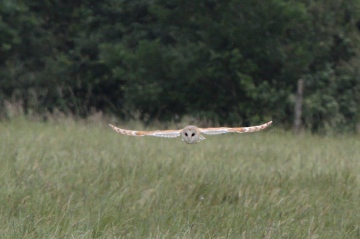 Barn Owl - John Lilley
Barn Owl - John Lilley
Barn Owls galore! The past two summers have been bad news for Barn Owls. Contrary to popular belief they rely on hearing more than sight when hunting. For that reason they find it difficult to find prey during periods of heavy rain or strong winds. Remember the summer of 2012? Did it ever stop raining between April and June? And the late winter last year. Three months of constant north-easterly gales from February to April. Many Barn Owls starved to death and those that survived were often in no condition to breed. To add to their woes the population of Field Voles – the mainstay of their diet – had sunk to a four year low in their cycle of abundance. The Barn Owl Trust reckoned that the number of owls declined between 25% and – in a few places – almost 100% in the areas from which they receive reports and that nest-box occupancy was down 71%. At Blue House the experienced pair in the box in the farmyard managed to survive those wretched winds and eventually reared three owlets but the other two pairs on the farm did not even attempt to nest. What a difference a year makes! The vole population is on the rise once more and last week a check of the boxes revealed five chicks in both those on the grazing marsh and six in the box in the barn. This is one of the former, a young female (note the black spots on the underside) almost ready to fledge, a few wisps of fluff on the crown being the only giveaway. Dr Simon Cox, who ringed the owlets, reckons that 4-5 is the norm in boxes he has checked in north and east Essex this spring so, after two grim years, nature has addressed the balance back in the owls favour. Certainly, the one pictured here caught a vole within a few minutes of starting to hunt, even though it was the middle of the day. Daylight hunting can sometimes be a sign that food is scarce but in this instance there are probably not enough hours in the night to meet the demanding gapes of five hungry youngsters.
A desire to be first in the queue probably led to the undoing of one youngster in the box on the fleet, as it was found dead on the ground below. If they can find a perch nearby they will continue to be fed but once on the ground they tend to be ignored and, if not predated, eventually starve to death. Nick, the warden, has had to rescue such wayward owlets in the barn before now. |
Archives: May 2020Aug 2019 Jan 2019 Sep 2018 Jul 2016 Oct 2015 Jul 2015 May 2015 Apr 2015 Mar 2015 Feb 2015 Jan 2015 Dec 2014 Oct 2014 Sep 2014 Aug 2014 Jul 2014 May 2014 Apr 2014 Mar 2014 Feb 2014 Jan 2014 Dec 2013 Nov 2013 Sep 2013 Aug 2013 Jul 2013 Jun 2013 May 2013 Apr 2013 Mar 2013 Feb 2013 Jan 2013 Dec 2012 Nov 2012 Oct 2012 Sep 2012 Aug 2012 Jul 2012 Jun 2012 May 2012 Apr 2012 Mar 2012 Feb 2012 Jan 2012 Dec 2011 Nov 2011 Oct 2011 Sep 2011 Aug 2011 Jul 2011 Jun 2011 May 2011 Apr 2011 Mar 2011 Feb 2011 Jan 2011 Dec 2010 Nov 2010 Oct 2010 Sep 2010 Aug 2010 Jul 2010 Jun 2010 May 2010 Apr 2010 Mar 2010 Feb 2010 Nov 2009 Oct 2009 Aug 2009 Jul 2009 Jun 2009 May 2009 Apr 2009 Mar 2009 Feb 2009 Jan 2009 Nov 2008 Oct 2008 Sep 2008 Aug 2008 Jul 2008 Jun 2008 May 2008 Apr 2008 Mar 2008 Feb 2008 Jan 2008 Dec 2007 Nov 2007 current posts |



















